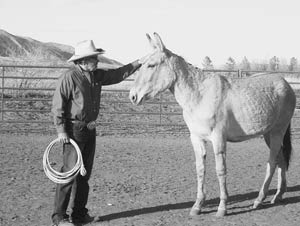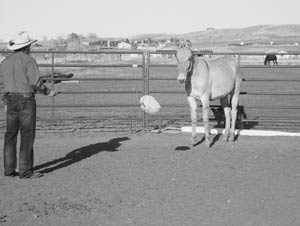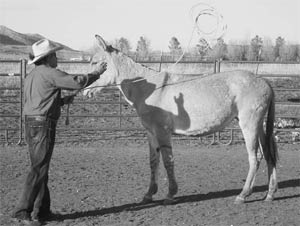All mules are born with the instinct of flight or fear in order to
survive. The amount of fear varies from mule to mule, but they all
have it to some extent.
As owners, it is unfair to ask our mules to be fearless. We can
never expose our mule to everything in the world and say, “Okay, now
you have NO fear”. Those expectations are unrealistic. Instead, we
have to understand that they have fear and now must teach our mules
what to do when they are afraid.
Despooking or sacking-out your mule is the best way to teach him or
her to relax in a high-anxiety situation. For instance, if you own a
mule that runs away with you, or is very fearful, despooking him
will help him cope with the world’s scary things and teach him to
relax and face his fear, rather than run from it.
More specifically, one exercise that can get your started is called
Spook in Place. You will want to work with your mule without a
halter, bridle or saddle on and preferably in a round pen. A 50 to
60 foot round pen is ideal; anything larger or smaller will make the
exercise difficult. Before you begin Spook in Place, your mule
should know the following cues: Go Forward, Come to You, Inside and
Outside Turns, Step.
 |
|
PRAISE THE Mule when the
mule gives you the correct answer |
To begin you must first understand that sacking out and despooking
often takes several training sessions to accomplish; it is not a
once or twice and we are done process. It often takes weeks, if not
months, to accomplish.
Now, gather several spooky or scary objects, for instance a towel or
a feed sack. You will also use yourself as a sacking out tool. Have
your mule stand on one side of the round pen and you stand on the
other side, with the mule facing you. Start by saying “Boo” softly.
If the mule does not move his feet, he has given you the correct
answer, praise him. If the mule moves away, ask him to come back to
you, then praise him.
Next, increase the volume of your “Boo”, or you can also add body
language, such as a bend in your knees or a raise of your hand.
Again, if your mule does not move his feet, he has given you the
correct answer, praise him. If he moves his feet, ask him to come
back, then praise him.
If you are teaching Spook in Place and your mule moves, but does not
come back to you, begin working on round pen work, such as inside
turns or outside turns. This will get the mule’s attention back on
you. This is not a punishment for your mule; instead it is a way to
get him refocused. After several minutes, ask the mule to come back
to you and try again. Soon, your mule will learn the easiest thing
for him to do is to stand still and face you and the scary object.
|
 |
|
TEACH YOUR Mule when he is
afraid, not to move his feet
|
The next step is to move a few feet closer to your mule. When you
can stand right in front of the mule, shout the word, “Boo” and wave
your arms, bend your knees, etc and if he does not move, you are
ready to move on to the next scary object….your towel.
Each time you introduce a new scary object, start far away and
gradually move closer as the mule accepts the object. I always look
to see if the mule is bored or falling asleep; this tells me he is
comfortable and ready to move on. What if the towel spooks the mule
so much that he will not stand still again?
First, make sure you did not move the towel too much or that you are
too close to your mule. You may have to back up or just hold the
towel in the air, then lower it. If you determine the towel is just
too scary for the mule, you need to find something less scary, a
brush, a smaller wash cloth or you may simply need to go back and
keep working on “Boo” and body language.
Work through as many items as you can from a brush or washcloth, all
the way up to a tarp. Some items in between can be a newspaper, feed
sack, plastic bag, saddle pad, umbrella, soda cans rattling in a
feed sack, etc; but not necessarily in that order.
Remember, no matter what object you are working with, go slow and
focus on keeping your mule’s feet in one place. If he moves you are
going too fast. Also remember to constantly praise your mule for
getting the correct answer…..but be sure to leave your scary object
where you were standing before you walk over to praise the mule.
When you are ready to move on to a new object, be sure it will raise
your mule’s emotional level a bit, without making him move.
 |
THROWING THE
lariat over the mules back
|
After working with these objects, the next step is to again stand in
front of your mule with a lariat. Initially you will hold one end of
the lariat and throw the other end directly to your right or left on
the ground, not at the mule. Again, throw it far enough away so that
your mule does not move his feet. As you progress, gradually throw
the lariat closer to your mule. Your mule will raise his head, his
eyes may get bigger, but you still want him to stand still.
When he raises his head and his eyes grow bigger, he is spooking,
but he is not running away, so he is giving you the correct
answer…..praise him. Keep working with the lariat until you can
throw it all around your mule.
Next, stand on one side of the mule and throw the rope under him,
then pull it back to you. Many mules do not like this because they
are seeing the lariat appear on the opposite side. Suddenly your
mule will see the lariat in his opposite eye. He may jump, snort,
even run off; ask him to come back and try it again.
When your mule stands calmly allow the lariat to rub against his
legs when you are pulling it back through. If you have a mule that
does not like things around his feet, this will fix the problem.
However, this step takes hundreds of tosses before your mule is
comfortable. Toss the lariat under, in front of and behind the mule,
then drag it back.
Your next step is to throw the lariat over the mule’s back and then
drag it back to you. Teach your mule to be comfortable with having
the rope all around and all over his body. Over, under, in front and
behind.
Once the mule is relaxed to the object you are working with, think
of something else that will raise his level of excitement. For
instance, tie a washcloth or towel to the end of your lariat and
start the tossing all over again….out to your sides first and
gradually all around your mule --- again under him and over him.
Be sure to do all of this without a halter, bridle or saddle.
Next you can drape the plain lariat over your mule’s withers, then
walk away and pull the plain lariat back to you. If your mule reacts
to the lariat moving stop pulling the lariat, then try again.
In the end your mule will be happy to face a multitude of scary
objects. This is ultimately what you want…..a mule that has learned
to stay and face a scary object, not run from it.
One a side note: Some saddle mules may run away with people for
various reasons. Spook in Place is one exercise you can do to help
your mule cope, but understand it may not be the only exercise you
need to solve the problem.
Tim can be reached at
www.diamondcreekmules.com, or by phone at 307/899-1089, or
email:
bliss@wavecom.net.
|